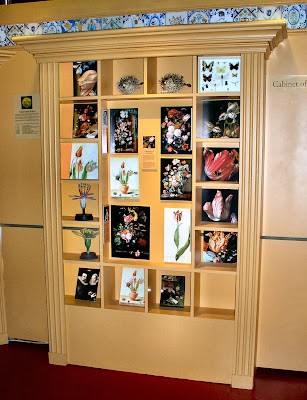Tulips came to the Netherlands around 1550 from Istanbul, of all places. In the lavish palaces in 16th century Istanbul, the sultans collected, nurtured and displayed large quantities of tulips. This beautiful flower, called “tulip” after the Turkish word for “turban,” was brought to Holland from Turkey and quickly became widely popular. Tulip prices steadily rose with their growing popularity, and bulbs were purchased at higher and higher prices by speculators who planned to turn around and sell them for a profit. By about 1610 a single bulb of a new variety was acceptable as dowry for a bride, and a flourishing brewery in France was exchanged for one bulb of the variety “Tulipe Brasserie.” During Tulipmania, 1636-1637, tulip bulb prices rose to incredible heights before collapsing and plunging the Dutch economy into a crisis that lasted for many years.
Canal Houseboat with directions to the Tulip Museum
I would never have known there was such a thing as a “Tulip Museum” if I hadn’t seen a sign on a charming houseboat in a canal across from the Anne Frank House. The sign said that the museum was 100 meters away and had an arrow pointing in the correct direction.
Closeup of houseboat
Bikes in front of the Tulip Museum
Bikes and tulips--there are bike paths right alongside streets throughout Amsterdam, and bikers rule. If you walk in the bike path, you are taking your life in your own hands.
Front of the Tulip Museum
The store front indicated that it was the Amsterdam Tulip Museum, but it was really a gift shop with a small museum on a lower level.
Cheese Museum
If tulips aren’t your thing, you can always pop into the Cheese Museum, which is right next door to the Tulip Museum.
Flowers in front of the museum
These frilly tulips were on display in front of the museum/shop.
Tulip Gift Shop
Miscellaneous small items bearing a tulip motif in the gift shop, including Christmas ornaments (!), fridge magnets, tea towels and note cards.
Dishware with a tulip motif on display in the gift shop
A wall display in the gift shop with a number of different vessels in which to display tulips
Dishware with a tulip motif on display in the gift shop
A wall display in the gift shop with a number of different vessels in which to display tulips
A wall of tulip pictures in the museum proper
The museum was down a flight of stairs, but people were more interested in buying tulip items than in learning about tulips, so I was alone. The displays in the museum were delightful and varied. I never knew tulips had such a fascinating history.
Processing of tulip bulbs
Tulip bulbs were and are big business in the Netherlands. On the shelves are authentic bulb industry artifacts and old-time photos which recorded the bulb-processing system.
Bulb-processing artifacts and old photos
Loading up the bulbs for transport
Tulip bulbs on display
A Turkish boy in the Sultan’s garden
Sultan Solimano XII
Sultan Suleyman the Magnificent (1494-1566) kept his tulips in his “Abode of Bliss,” an inner sanctum at the Topkapi Palace, planted exclusively for his enjoyment.
Model of the Sultan’s Ottoman palace
Display of Arabic porcelain with a tulip motif
Close-up of the porcelain
A Rembrandt painting of his wife, Flora .
Rembrandt painted his wife Saskia as Flora, goddess of spring and flowers. This painting dates from 1634, the year of their marriage and the beginning of Tulipmania in Holland. Saskia is depicted with a flamed red and white tulip drooping from her floral headdress.
According to myth, Flora had been a notorious courtesan in the earliest days of Rome. When she died, she left much of her earnings to the city, and in return, the grateful Romans deified her. She became both the goddess of flowers and the protector of prostitutes. Seventeenth century Dutch pamphleteers delighted in drawing parallels between Flora and tulips. Flora, they reminded their public, had made a practice of selling herself to the highest bidder, and her price had risen constantly until it was so steep that no man could afford to keep her to himself for long.
Cabinet of Curiosities, featuring tulips. To the left of the cabinet is a list of Tulipmania prices.
Tiers of floral paper cuttings of an Ottoman garden
Tulips displayed in tall glass vases
Tulips in a glass vase
Pyramid tulip vase
To this day in modern Turkey the tulip is still considered the embodiment of perfection and beauty.
The museum was informative, and the displays were unique. You will probably never again see an assemblage of exhibits solely devoted to tulips. The museum is a must-see if you are a tulip devotee, if you would like to buy a tulip memento of Holland for yourself or as a gift, or if you would like to gain a new appreciation for the history of tulips and their effect on the economy of the Netherlands.



























No comments:
Post a Comment